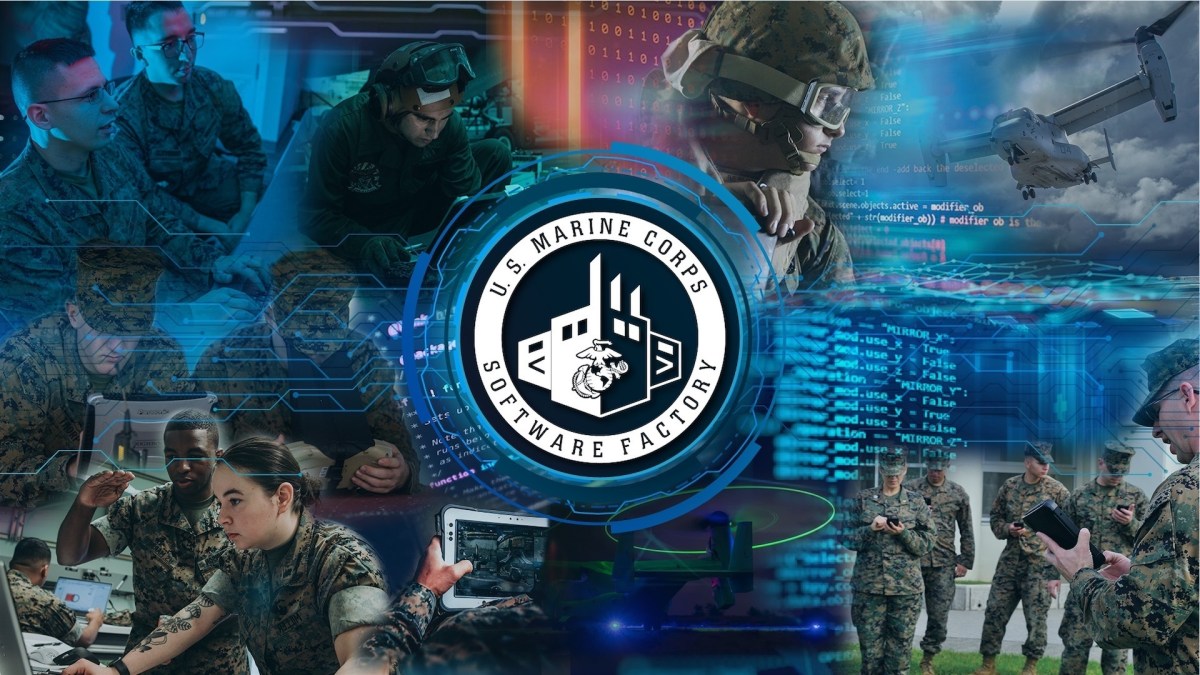Marine Corps software factory rolls out 4 new apps for tactical and back-office operations

Marines from the service’s new software factory have delivered several applications that troops can use for tactical or back-office purposes, according to the officer leading the organization.
The Marine Corps Software Factory (MCSWF) was stood up in 2023 as a three-year pilot to hone and demonstrate troops’ coding skills, show that there’s a demand for the concept and that it can be scaled. It’s co-located with the Army Software Factory in Austin, Texas, one of the nation’s top technology hubs.
“What we’re doing is we’re almost singularly focused on generating a force with the right technical skill sets to be able to provide an operational capability in terms of digital operations. And when I say ‘digital operations,’ I’m talking about software development, data analytics, AI, machine learning, that type of thing. Just to provide these commanders a meaningful way of being able to compete with our peer adversaries,” Lt. Col. Charlie Bahk, a communications officer and director of the organization, said during a panel at GovCIO’s Defense IT Summit Feb. 9.
Marines there have already churned out four new applications. Three of them are tactical in nature, he told DefenseScoop during an audience Q&A at the event.
“I have to be cognizant of the clearance levels, you know, OpSec and all that. But one of them is about maximizing our maritime radar assets to be able to give the fleet commander a more comprehensive picture of what is happening in that domain. And it’s fully interoperable. It’s interoperable with not just one, but multiple different types of sensors out there. Full-motion video as well,” he noted.
Another uses QR-code technology that can transmit information from unit to unit across long distances and in areas where satellite transmissions or radio transmissions are being jammed and impeded.
The other tactical app is related to “blue-force” signature management, or “understanding where or how brightly you glow on a common operational picture, based off your electromagnetic spectrum activity,” Bahk said.
The fourth app is intended to streamline back-office operations.
“It’s on the garrison or the business side where our monitors or detailers, you know, like the people that cut orders for Marines to their next assignments and work out the retention packages and things like that,” he noted. “You can imagine, due to the sheer numbers of people that they have to engage with, the potential for miscommunication and long wait times and missed appointments and hurt feelings … I mean, it’s just tremendously high.”
To address that, the software factory built a tool to gather data from service members before they meet with those types of officials.
“What we’ve done is created a simple application that streamlines a lot of that, cuts down dramatically the wait times for each of those Marines. It compels them to preload a lot of the standardized information that the monitors should already know about them, [such as] whether or not their spouse is in a graduate-level program or has a very important job or if they have an exceptional family member in the family,” he explained.
The interview window is short, in many cases only about 10 minutes, according to Bahk. The app is intended to make better use of that time.
“Most of those 10 minutes are used in discussing things that should already be known. So what this application does is it helps us streamline the flow of information. And now all of those 10 minutes are used in meaningful conversation that the Marine wants to cover with their monitor. Which if you ask me, I think that downstream of this, it helps to feed into the Marine’s mindset as far as: ‘Am I cared for by the institution? Should I reenlist? Do I want to continue to serve?’” Bahk said.
The software factory pilot is unfolding at a time when the Pentagon is putting increased emphasis on digital modernization and the rapid fielding and upgrading of software. That trend is expected to continue as the military acquires more AI capabilities and pursues new warfighting concepts like Combined Joint All-Domain Command and Control (CJADC2).
Building up coding skills within the Marine Corps is seen as a way to better connect software gurus with deployed warfighters and provide operational value more quickly without relying on contractor support.
“When we have organic uniformed service members doing this type of work and leveraging the infrastructure … we tend to immediately open up a line of like an iteration loop, that’s a line of communication with the commanders on the ground, and say, ‘Hey, here’s our [minimum viable product] that we’re delivering to you within weeks — days, weeks and months, not years. Right? And make sure that we got it right. And if we don’t, roger that, we’ll see you next week and we’ll deliver it — or we’ll see you later today,” Bahk said.
“When we delivered these applications, we got to see them employ it in real-time. And as any rollout goes, there are a couple of hiccups here and there. Zero findings, but a couple of hiccups, performance issues — or maybe the users then think of a feature that they would like us to work on and deploy. We were able to do that. And we’re doing that today, within the same day. We’re pushing to production several times a day. And the responsiveness and the quality — the user base is tremendously happy with that model,” he said.



